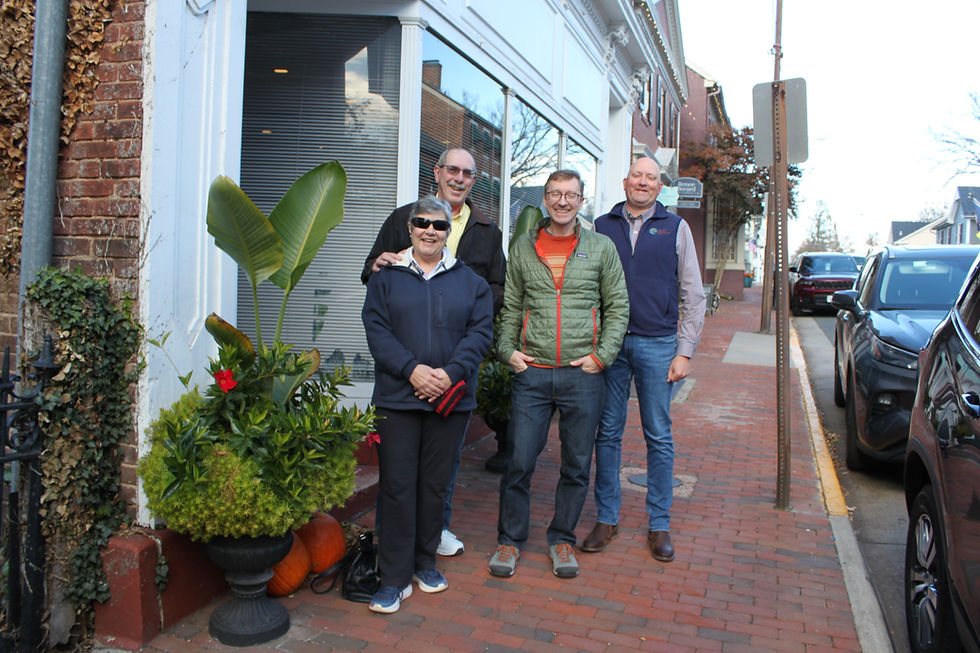Top 10 Natives to Plant This Summer
- NVCT
- May 15, 2025
- 4 min read
April showers have passed and May flowers are springing all around Northern Virginia! As summer approaches, gardeners and conservationists have the perfect opportunity to support local ecosystems by planting native species. Native plants are beautiful, adapted to our region’s soil and climate, require less water and maintenance, and provide critical habitat for birds, pollinators, and other wildlife. Here are ten top native plants to consider adding to your garden this spring:

1. Purple Coneflower (Echinacea purpurea)
This popular native wildflower is both ornamental and ecological. It blooms in early summer and is found in open woods, meadows, and prairies. It provides nectar for pollinators and seeds for birds later in the season. Goldfinches in particular love to munch on the dried seeds of these flowers!

2. Black-eyed Susan (Rudbeckia hirta)
With cheerful golden-yellow petals and a dark center, Black-eyed Susan is a hardy, sun-loving perennial that supports a wide range of bees and butterflies. These flowers can often be found in wildflower mixes used for restoration projects in the area.

3. Butterfly Weed (Asclepias tuberosa)
Bright orange flowers make this milkweed species a standout in sunny gardens. These orange starbursts are a magnet for butterflies and other pollinators. Monarch butterflies, in particular, love this flower as they use it as a larval host. This native plant is also hardy as it can survive in sandy soils and is extremely drought tolerant! So if you’re new to building a pollinator garden, this is a great plant to start with!

4. Cardinal Flower (Lobelia cardinalis)
Its stunning red blooms attract hummingbirds due to their tube shape that is perfect for sipping nectar! An excellent choice for wetter areas or rain gardens. Once established, it requires little care and returns reliably each year. It's also deer-resistant, making it a great choice for rural or forest-edge properties.

5. Virginia Bluebells (Mertensia virginica)
A true springtime showstopper, Virginia Bluebells produce clusters of bell-shaped, blue flowers. They naturalize well in moist, wooded areas and attract early pollinators. These flowers start out pink and change to a light purple to blue shade. These popular perennials attract honeybees, sphinx moths, butterflies, and hummingbirds. Deer also tend to avoid eating these flowers.

6. Joe-Pye Weed (Eutrochium purpureum)
Folklore claims that this plant is named after a Native American herbalist named Joe Pye who used this plant to treat fevers and typhus. This elegant plant thrives in moist soils and draws in butterflies with its pink-purple blooms. Joe-Pye weed is a favorite of the vibrant and iconic Virginia State Butterfly, the Eastern tiger swallowtail, and is a host for multiple native moth species! These tall plants can help add dimension to your garden and have a sweet vanilla scent. Plant Joe-Pye Weed in groups along borders, wet ditches, or woodland edges.

7. Eastern Red Columbine (Aquilegia canadensis)
This delicate, red-and-yellow bloomer adds color to shady gardens and is a favorite of hummingbirds. It thrives in part shade and well-drained soil. Red Columbines can be found throughout the eastern United States, and they’re bell-shaped flowers open when in full bloom! A bonus is that these flowers are considered deer resistant!

8. Wild Bergamot (Monarda fistulosa)
Also known as bee balm, this fragrant, lavender-flowered plant attracts bees, butterflies, and hummingbirds. It is also a larval host for orange mint and hermit sphinx moths. Plant in full sun to light shade and well-drained soil. It thrives in dry conditions once established and blooms mid- to late summer — just in time to fill in those garden gaps.

9. New England Aster (Symphyotrichum novae-angliae)
Just when you think the show is over, New England aster steps into the spotlight. With vivid purple petals and golden centers, these late-season bloomers are a lifeline for migrating monarchs and other pollinators stocking up before winter. Plant in full sun with moist, well-drained soil — though they’re adaptable to clay and drought once mature. Don’t be afraid to pinch them back in early summer to encourage bushier growth and even more blooms come fall.

10. Little Bluestem (Schizachyrium scoparium)
Add texture and movement to your garden with this native grass. Its blue-green blades turn copper in the fall, and it supports ground-nesting birds and butterflies. This tough, drought-tolerant species is ideal for restoring meadow-like aesthetics while providing critical habitat and nesting sites for ground-dwelling insects and birds. Plant in full sun and lean, well-drained soil — avoid overly rich sites to prevent flopping. It’s a low-maintenance stunner that does real ecological work.
Planting natives isn’t just about gardening—it’s about conservation. By incorporating even a few of these species into your yard or community space, you’re helping to restore the rich biodiversity of our Northern Virginia landscape. But where can you find these seedlings? NVCT partners with multiple native plant advocacy groups that provide NoVa residents with the resources needed to get their garden blooming with natives! Explore resources from Plant NOVA Natives at [www.plantnovanatives.org](https://www.plantnovanatives.org) or visit Earth Sangha’s Native plant Nursery in Springfield!








Comments